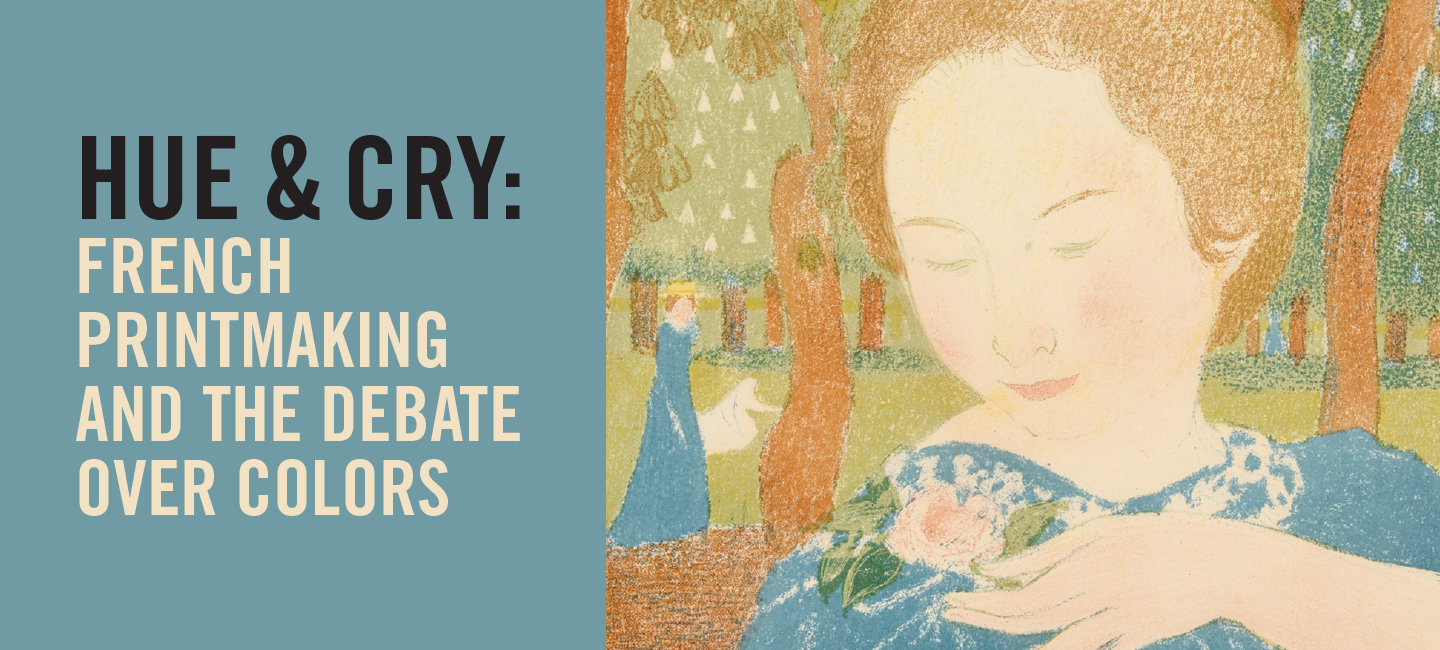PRINTMAKING TECHNIQUES AND TERMS IN HUE & CRY
INTAGLIO PRINTING
Intaglio refers to any printing process that involves cutting a design into a matrix, usually a metal plate.
Engraving: In engraving, a design is cut with a sharp pointed tool (called a burin) directly into a metal plate. The engraved plate is then inked and wiped carefully so that ink remains only in the incised grooves. This is the design that will print onto the paper.
Etching: Etching relies on the action of acid, rather than direct cutting, to produce a design in a metal plate. The plate is first covered with a waxy acid-resistant resin, called a ground, and then an etching needle is used to draw a design. The needle has only to penetrate the waxy ground to expose the metal plate, which once bitten (or submerged) in an acid bath, will result in incised grooves that hold ink and produce the design. The depth and thickness of the printed lines depend on how long the plate stays in the acid bath.
Aquatint: The aquatint process involves heating a powdered, acid-resistant resin on a metal plate. This results, in an irregularly mottled surface when the plate is exposed to acid, producing an overall wash-like or tonal effect when the plate is inked and printed. The areas of the plate protected by grains of resin will print as white, while the areas around the grains will be bitten by acid and therefore hold ink. This process is well adapted to combination with etching.
Color intaglio methods: The most complex color intaglio prints were produced by the multiplate method, using a separate plate for each hue. Ink of a single color would be applied to the areas of the plate where it was needed for the design. By repeating this step and sending the same piece of paper through the press each time for as many colors as necessary, the image was built up additively (or progressively). Drying time had to be factored in between each pass through the press. A simpler method was à la poupée printing, in which the plate was inked simultaneously with all the colors needed (using a dauber called a poupée) and given just one pass through the press. Though à la poupée printing saved on money and time, it could result in muddy effects due to color bleeding.
WOODBLOCK PRINTING
The technique of woodblock printing involves drawing a design on a woodblock and carving away the areas around it, leaving behind a network of lines in relief that can be inked and printed.
Chiaroscuro woodcut: Chiaroscuro woodcut was a popular method of printing color during the Renaissance, and the only reliable method until well into the eighteenth century. Two or more color woodblocks could be used to print areas of different tone within or in contrast to the key block, the outline design that was usually printed in black. Chiaroscuro woodcut was effective in suggesting three-dimensional modeling and sculptural form, though it was too crude to allow for finely detailed color gradations or more subtle wash effects.
Ukiyo-e: Ukiyo-e, which translates literally to “pictures of the floating world,” refers to a style of Japanese color woodblock printmaking that surged to prominence in the Edo period (1603–1867). Common subjects were actors and entertainers, as well as views of famous places. Ukiyo-e prints were admired by many European artists of the later nineteenth century.
LITHOGRAPHY
Invented in 1798 in Germany, lithography is a method of printmaking that relies on the repulsion between grease and water. A design is made with a greasy substance on a highly polished limestone, which can then be printed in large quantities without any degradation or decline in quality. Though black-and-white lithography already required a specially trained technician to manage the print process, color lithography was yet more complex. The technology and expertise needed to achieve consistent color effects in lithography were not available in France until late in the nineteenth century but then had a spectacular flowering in the 1890s.
Chromolithography: Chromolithography is a label often given to color lithographs that reproduce paintings or other works of art for a mass market. These prints were seen as less artistic than fine-art lithographs, but the process used is essentially the same and many firms made prints of both types. The main aesthetic difference between chromolithographs and color lithographs of the late nineteenth century is that reproductive “chromos” are more thickly layered, to give the illusion of paint. Some even mimic the texture of a canvas weave underneath.
ARTIST’S PROOF
An artist’s proof (also known as a test proof or trial proof) is an impression taken before a print reaches its final form; in color printing, this is often an important step in checking color balance. An artist may make notations on the trial proof that serve as instructions to the printer. Once the print has been approved after one or more trials, it may be ready to offer for sale in the marketplace, perhaps as an edition (a print run of a fixed number of copies).
HAND COLORING
Hand coloring refers to color that is added after the printing process is complete: for example, watercolor applied with a brush. This exhibition deals mostly with printed color—color that is integrated into the printing process.
